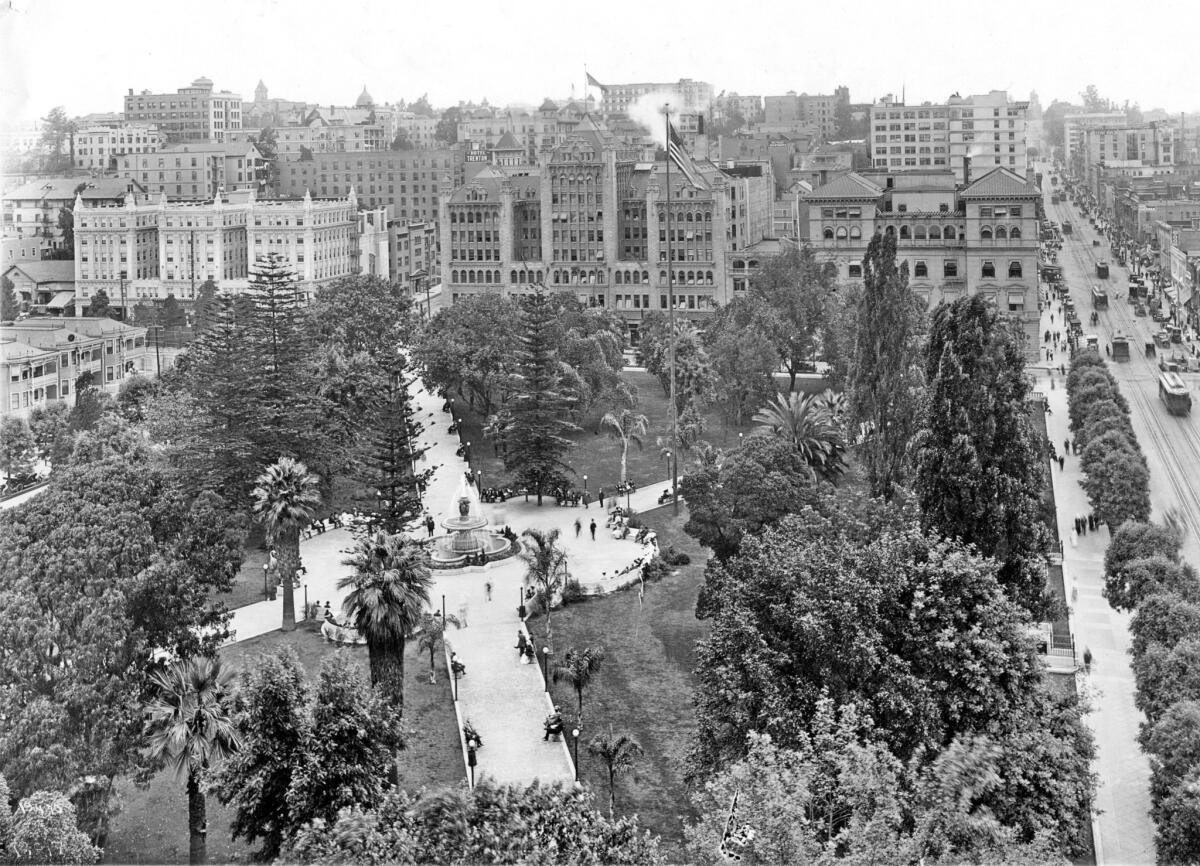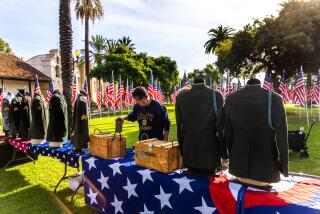Opinion: Memorial Day 1919: ‘What shall be for memory?’

Los Angeles’ Central Park sometime before it was renamed Pershing Square in 1918.
As a history buff, I like browsing through old newspapers (not to mention archives) seeking links to the present, which led me to dust off the Times’ editorial from Memorial Day 1919 - the first commemoration following the end of World War One.
It’s a pretty long editorial for what was, for the Americans anyway, a short war, and is less about war than about memorialization itself. In the go-go pro-business climate of the era, the Times noted that it was rationale to get double use out of a memorial. Say, a bridge dedicated to the dead, thus getting some public good out of the spent tax dollars.
------------
FOR THE RECORD
An earlier version of this post misstated the year of the editorial as 1918. It was 1919.
------------
But it also argued - in purplish prose - that the future would be watching, so they ought to ensure they do it right.
It’s unclear whether the two memorials mentioned below ever came into being, but in 1918 the Los Angeles renamed a park at Sixth and Hill streets Pershing Square, after war hero Gen. John J. Pershing. Five years later the Memorial Coliseum opened as a commemorative to the war dead. The concept and design seem to have followed one of the themes of the Times editorial: Make it grand, and as a testimony to the future about what mattered at the time.
-----
What shall be for memory?
What shall be for memory of the American soldiers who died in France and Flanders and on many another far and alien field for the peace and freedom of the world?
What shall be for memory, as well, of our soldiers who have returned from the great war maimed and wounded? And what for memory of those who were spared the battles, but who stood ready to make any sacrifice that another had made?
And what for the memory of our sailors, and of our marines who were soldiers and sailors, too?
What shall be for the memory of them now and in the years to come when there shall have long passed forever from earth all who live in these times and who were witnesses of the most stupendous crisis through which civilization has ever passed?
As far as we are concerned who live today, we need no memorial save our own hearts. But this will not be so with generations to come. Hence, it is for us to build the memorials which shall commemorate the deeds that have now been done, and that the men from out whose souls those deeds were wrought shall be known and remembered until earth itself shall crumble and God calls back the sea.
Wherefore, of what character and of what nature shall be the memorials that we are now to build?
Throughout all America today this is a subject of deep concern. Not even the smallest or most unimportant community can escape the problem. Or desires to escape it, for there is no community, great or small, without its sacrifice made upon freedom’s altar.
There can be no doubt that another year will see begun, and a few years more will see completed, thousands upon thousands of these memorials. They shall rise upon hilltops and in valleys throughout the whole land.
The sum total of money to be expended on these memorials will be very great. This is one consideration. And that which we shall build shall be builded more for those who come after us than for ourselves. And this is the other, and by far the most important consideration.
So, what would you say would constitute the truest, the best and the most lasting memorials to the American soldiers sailors and marines who died, or were ready to die, for the peace and freedom of the world?
Obviously to aid communities in making a decision in so important a matter, there has been published a pamphlet by an apparently semi-official bureau of the government in which many suggestions are made.
One cannot help but be impressed from a perusal of this pamphlet with the conviction that it is the aim of its editors to encourage the people to make their memorials utilitarian. The idea seems to be that it is best to combine sentiment with business.
And, at first blush, this would seem to be the right idea. Let us build a bridge, it is suggested, in memory of our heroes; we can put an inscription on the bridge, with the names of the dead, and then we can use the bridge for traffic. Or, let us, in the same way, and with the same business-like reasoning, build a civic auditorium, a stadium, a street, or even a public playground, if you please—things that should be built and must be built, anyway—or, maybe a hospital, in memory of the dead.
The point is that we can thus “kill two birds with one stone,” as the saying has it.
We are not to forget, it seems, that this is a profoundly practical age—a utilitarian age, pre-eminently. If we are to do anything for the sake og a sentiment, let us see to it that the money will come back.
Yet, somehow, granting that we should be practical, and that whatever we do should be something done in the way of usefulness, we fund ourselves not wholly enamoured of the suggestions along this line.
We find ourselves thinking, instead, that since the commemoration is to be of a sacrifice made by the dead and of the immolation of the living in a holy cause, that the memorials that we are to build should breathe out of the very stone and bronze of which they are to be made, the soul of sacrifice.
In other words, we should give the money to build these memorials in the same way that we gave to the Red Cross—giving and knowing that it was money that could never come back, directly or indirectly.
And it also seems to us that there are two other considerations to be taken into account, namely, that it is alone through symbolism that a sentiment can be perpetuated, and that we must consider that we shall be judged of future generations by the memorials that we hand down to them.
If this be true, were it not then a difficult matter to make a bridge, a civic auditorium, a stadium, or even a hospital, symbolical?
But, granting that we could do so, is it not likely that future generations, judging use from our monuments—the only way a generation can judge its predecessors—would it not be said a hundred or a thousand years from now that we were a canny folk?
“They remember their dead,” writer of the future might say of us, “but they made the dead work for it.”
God save us from anything like that!
Concerning this discussion as applied locally to Southern California, our attention has been called to two particular projects already under way an which appeal to us as being fundamentally right.
We refer to what has been proposed to do at the Mesa Grande Indian reservation and at Riverside.
Mesa Grande sent several Indian boys and two or three white boys to the war. Death spared them all except one of the white boys, who gave his ife in the red slaughter of the Argonne Forest. And, that he shall be forever remembered, it is proposed to build a stone arch across the great mountain highway at mesa grande, upon which shall be inscribed his name and his sacrifice.
They need a bridge at Mesa Grande, and more than one, but they think the stone arch will be better.
The project at Riverside is more ambitious. And it is wonderfully beautiful. There, it is proposed to blast a place for a shrine in the heart of the star-crowned summit of Mt. Rubidoux, and in that shrine to place a figure of Christ, a war-shattered cross from a field in Flanders, and a group of sculptured figures to represent Riverside’s heroic dead, with the legend of their sacrifices and their names cut into the granite of the mountains and raised on tablets of bronze.
There is nothing utilitarian about that. But, it is thought so exquisite in its beauty that, if carried to completion, it will challenge the admiration of the world. It will take a place with the “Christ of the Andes.”
The “Christ of the Andes” is a heroic figure of the wanderer of Galilee erected on the summit of those mighty mountains, where the border line runs between Chile and the Argentine. It was erected by the people of both those nations to commemorate the pact of everlasting peace that was made between them. On the base of the statue these words were inscribed:
“Sooner shall these mountains crumble than the peace between Chile and Argentina be broken.”
And to justify and to speak that vow there was no way except to rear to the blue skies the symbol of the Prince of Peace—the traditional figure of His body as He walked in life, and the symbol of the cross on which He died that all men might be brothers.”
It is through their art that Egypt and Greece and Rome speak to us from the past, and it is through whatever art we shall leave behind us that future generations shall vision us.
It is said that we are a commercial people, and so we are. But we are also a great-hearted and a beauty-loving people. And we are a grateful people.
Whatever we have in our pockets, we are glad to give to make expression of ot loving memory of these bright, brave lads of ours who sleep now afar in Flanders fields and wherever they seep after the battles and the red slaughter of war.
This is the way we feel, and it is the way that we want the future to know we felt. But, we can easily create a false impression of ourselves, which is something that we must be at the greatest pains not to do.
And the question to put to ourselves, then, is this: What is it that is in our hearts now regarding the living and the dead who strove to bring peace upon the earth and liberty to all the peoples of the world?
Is it not in our hearts to pay them a tribute that shall have no suspicion of selfish motive in it? Is it not to say to future ages that out of our gratitude to those who died and to those who were ready to die, we were eager to give to the winds and suns of heaven—if that would speak us best—all that we had or ever hoped to have?
So, let certain of our memorials be true memorials, not only of those whom we commemorate and who gave their all, but of us, who shirked not to make whatever sacrifice was asked.
Follow Scott Martelle on Twitter @smartelle.
More to Read
A cure for the common opinion
Get thought-provoking perspectives with our weekly newsletter.
You may occasionally receive promotional content from the Los Angeles Times.







